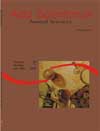<b>Scrotal perimeter and age of puberty in Australian Merino Sheep, submitted to different alimentary strategies</b> - DOI: 10.4025/actascianimsci.v27i4.1179
Abstract
The hypothesis that animals well fed during the fetal life and in the post parturition would present better reproductive performance than those with restricted feeding, during the fetal life and/or in the post parturition was experimented pointing out that younger animals reach puberty first. One hundred and twenty pregnant Australian Merino sheep were used on the 60th day of gestation, distributed in a 2x2 factorial, with four nutritional levels, half of groups being were inverted. Birth weights were recorded. The females were eliminated and the males were identified by using earrings of different colors (orange, purple, black and green) distributed among the treatments. Body score maintained the same relations that were observed on body weight. Animals with black earring presented smaller scrotal perimeter on the 132nd day, with larger scrotal growth, due to the nutritional improvement of those animals on specific periods. As a condition of corporal score, the scrotal perimeter maintained the same relationship among the groups observed for the body weight: the orange group presented the highest perimeter, followed by the purple, green and black group. Only 62.5% of the animals reached puberty until the end of the experiment. Animals reached puberty with the same score, scrotal perimeter and age, albirt they presented different weightsDownloads
Download data is not yet available.
Published
2008-03-14
How to Cite
Mancio, A. B., Lomas Santiago, L., Goes, R. H. T. e B. de, Franco Martins, L., & Cecon, P. R. (2008). <b>Scrotal perimeter and age of puberty in Australian Merino Sheep, submitted to different alimentary strategies</b> - DOI: 10.4025/actascianimsci.v27i4.1179. Acta Scientiarum. Animal Sciences, 27(4), 449-457. https://doi.org/10.4025/actascianimsci.v27i4.1179
Issue
Section
Animal Breeding and Reproduction
DECLARATION OF ORIGINALITY AND COPYRIGHTS
- I Declare that current article is original and has not been submitted for publication, in part or in whole, to any other national or international journal.
The copyrights belong exclusively to the authors. Published content is licensed under Creative Commons Attribution 4.0 (CC BY 4.0) guidelines, which allows sharing (copy and distribution of the material in any medium or format) and adaptation (remix, transform, and build upon the material) for any purpose, even commercially, under the terms of attribution.
Read this link for further information on how to use CC BY 4.0 properly.
0.9
2019CiteScore
29th percentile
Powered by 








































